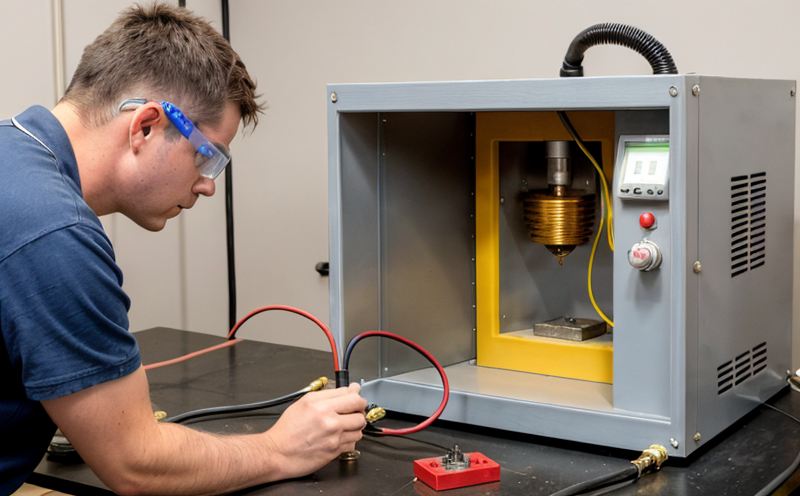ASTM A342 Relative Magnetic Permeability of Materials
The ASTM A342 test method is a critical standard used to evaluate the relative magnetic permeability of materials. This property is essential for understanding how different materials respond to an external magnetic field, which is fundamental in various industries including metallurgy and material testing.
Magnetic permeability measures the ability of a material to support or guide a magnetic field. It is typically expressed as the ratio of the magnetic flux density (B) to the magnetizing force (H). This test helps determine how effectively materials can concentrate or direct magnetic fields, which is vital for applications such as transformer design, electric motors, and electromagnetic compatibility studies.
The ASTM A342 method uses a permeameter to measure the relative permeability of ferromagnetic materials. The permeameter applies an alternating current through coils surrounding the specimen to generate a magnetic field. The resulting magnetic flux density is then measured as the specimen passes through this field. This process allows for precise determination of how the material affects the magnetic field, providing insights into its suitability for specific applications.
Preparation of specimens is crucial for accurate testing. Specimens should be free from surface defects and contaminants that could affect the test results. Prior to testing, materials must undergo mechanical and chemical treatments as specified in ASTM A342 to ensure consistency and reliability.
The ASTM A342 method is particularly relevant in industries where precise control over magnetic properties is essential. This includes electrical engineering, aerospace, automotive manufacturing, and more. By understanding the relative permeability of materials used in these sectors, engineers can optimize designs for efficiency and performance.
Scope and Methodology
| Test Specimen | Ferromagnetic materials with a rectangular cross-section |
|---|---|
| Magnetic Field Strength | Alternating current field ranging from 10 to 50 kHz |
| Data Collection | Measurement of magnetic flux density at various points along the specimen |
| Calculation | Determination of relative permeability using the formula: μr = B/H |
- Prepare specimens to ASTM A342 specifications.
- Calibrate permeameter according to manufacturer's guidelines.
- Apply magnetic field and measure flux density at specified intervals.
- Calculate relative permeability using the provided formula.
The process involves a series of steps designed to ensure accurate measurement. The specimens are prepared in accordance with ASTM A342, which specifies the dimensions and conditions necessary for reliable testing. Calibration of the permeameter is critical to ensure that measurements are accurate and consistent across tests.
During testing, the magnetic field strength is controlled within a specific range to avoid saturation effects that could skew results. The flux density is measured at various points along the specimen to capture its spatial distribution accurately. Once collected, these data are used to calculate the relative permeability of the material using the formula μr = B/H.
Customer Impact and Satisfaction
- Better design optimization for transformers and inductors.
- Increased reliability in electromagnetic compatibility studies.
- Enhanced performance of electrical devices through improved material selection.
- Cost savings from more efficient manufacturing processes.
The ASTM A342 test method has a direct impact on the quality and performance of products across various industries. By providing accurate data on magnetic permeability, it allows customers to make informed decisions about materials that best meet their needs. This leads to higher customer satisfaction through improved product reliability and performance.
For instance, in the automotive industry, understanding the magnetic properties of components can lead to more efficient electric motors and better-performing transformers in powertrains. In aerospace applications, accurate permeability data ensures that materials are suitable for high-stress environments where electromagnetic interference could be critical.
Competitive Advantage and Market Impact
- Increased market share through superior product performance.
- Enhanced reputation for delivering high-quality, reliable products.
- Premium pricing due to advanced material selection.
- Reduced time-to-market by optimizing design processes.
The ASTM A342 test method provides a competitive edge by offering detailed insights into the magnetic properties of materials. This information allows companies to differentiate their offerings in the marketplace, enhancing their reputation and customer loyalty. Premium pricing can be justified through the superior performance of products that result from informed material selection.
In addition, the ability to optimize design processes based on accurate permeability data reduces time-to-market, allowing companies to bring innovative products to market faster than competitors. This not only leads to increased market share but also fosters continuous improvement in product quality and reliability.





